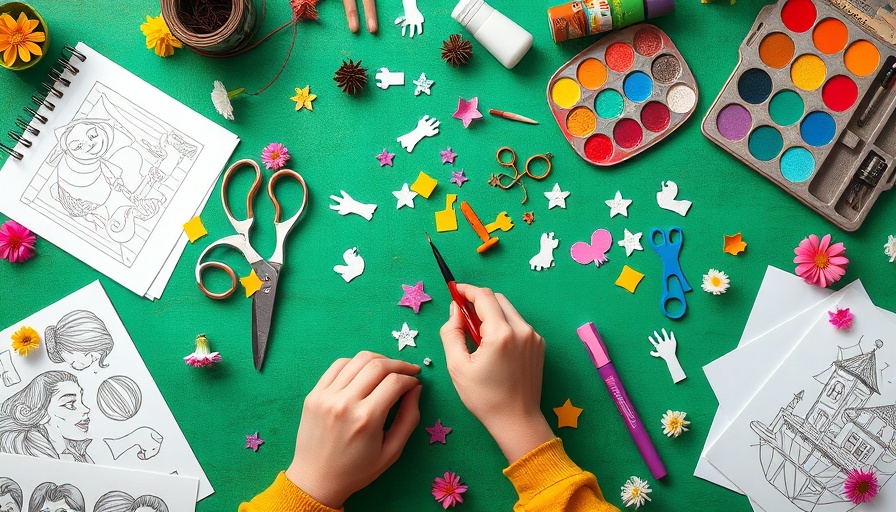
Crafting Connections: Uniting Through Creativity to Combat Loneliness
Loneliness is a universal experience that affects many of us, transcending age, culture, and social status. As our lives become increasingly digitized, the paradox of being more connected yet feeling more isolated is an unsettling reality. With loneliness officially recognized as a public health epidemic, it’s essential to explore innovative ways to bridge the connection gap. Interestingly, a surprising yet powerful antidote to this widespread issue is the act of creativity through crafting.
Crafting: A Universal Language of Connection
Crafting has long been celebrated as a means of artistic expression, but it is far more than just a solitary pastime. When we engage in creative activities, we open ourselves up to a world of shared experiences. From knitting circles to painting workshops, crafting allows individuals to express feelings that often elude verbal communication. These rich interactions may forge lasting connections that are particularly vital for those who feel isolated or homebound. For instance, as highlighted by Anna Griffin from the CREATE community, crafting events can surpass demographic boundaries, bringing people from all walks of life together to celebrate creativity.
The Therapeutic Benefits of Crafting on Mental Health
Beyond its social dimensions, crafting acts as a powerful tool for mental well-being. Engaging in creative tasks can alleviate stress and induce a meditative state, where the drudgery of everyday life temporarily fades. A study conducted in the UK revealed that participating in arts and crafts flows positive neurotransmitters like dopamine, directly enhancing our mood and reinforcing the brain’s neural pathways. The therapeutic nature of crafting supports not only individual health but strengthens shared well-being experiences, as evidenced by community crafting initiatives such as 'Little Bird SOS' empowering individuals by creating, connecting, and sharing.
Creative Ways to Connect Through Crafting
If you’re looking for meaningful ways to weave creativity into your life, consider the following activities:
- Host a Crafting Connection Night: Gather friends or community members for a casual crafting session. Choose enjoyable projects like card making or simple DIY decor. This gathering allows participants to bond over their creations while enjoying each other’s company.
- Take Crafting Public: Spontaneously create in public spaces such as parks or libraries. This not only nurtures creativity but invites interactions with curious passersby. It’s a wonderful opportunity to foster unexpected community ties.
- Teach Your Craft: Sharing your crafting skills can create profound connections with others. Invite someone to join you for a crafting lesson in knitting or jewelry making. Sharing knowledge inherently breeds interaction, laughter, and joy.
Breaking Down Barriers: Crafting as a Community Bonding Experience
As Lisa Pidgeon poignantly illustrates through her work with Little Bird SOS, the benefits of crafting extend beyond mere enjoyment. Her project has created safe, supportive spaces where diverse groups gather, fundamentally counteracting isolation. The arts and health inquiry reflects a growing recognition of how creative activities can catalyze social connectivity and improve mental health in both clinical and community settings.
Supportive Environments: Where Creativity Thrives
Creating environments that encourage artistic endeavors, such as community workshops, can significantly amplify social connections. In these nurturing spaces, individuals are more likely to share experiences, leading to forged friendships and emotional support. These communal experiences resonate deeply, as crafting often becomes a shared journey that uplifts spirits and fosters genuine connections.
Inspiring Change Through Creativity
By embracing creativity and the arts, we can effectively combat feelings of isolation and loneliness around us. Take time to engage in crafting not just for the joy it brings but for the connections you have yet to discover. In a world that sometimes feels disconnected, let’s use our creativity as a means of fostering those essential bonds, enhancing well-being, and nurturing communities. Remember, every project has the potential to create a new link—be intentional about your creative practice as a pathway to connection.
If you're interested in exploring more about mindfulness through yoga and crafting activities, consider prioritizing a mindful lifestyle that intricately weaves creativity, community, and self-discovery.
 Add Row
Add Row  Add
Add 




Write A Comment